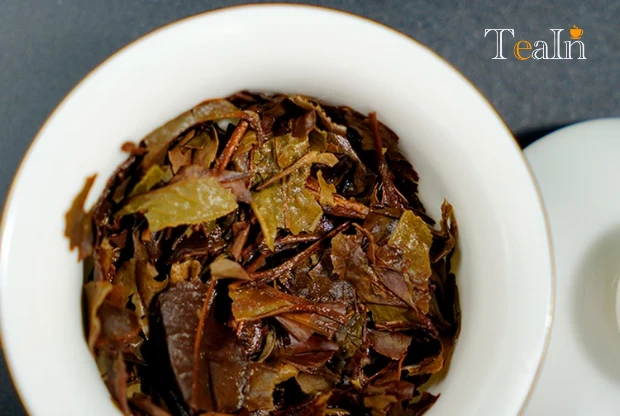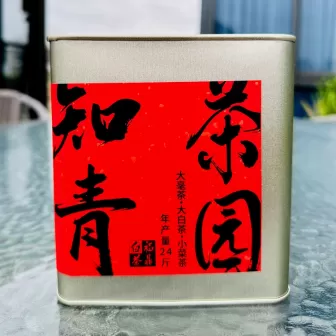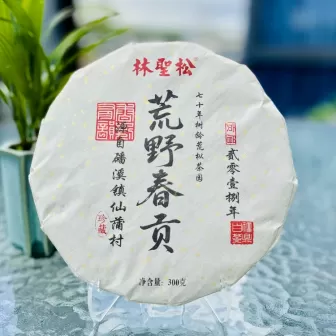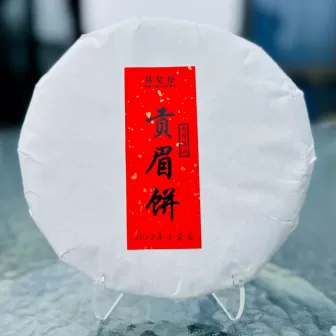Gongmei: The "Everyday Gem" of White Teas, Hiding Warm, Daily Aromas

When talking white tea, most people first think of the luxury of Silver Needle or the elegance of White Peony, often overlooking Gongmei Gongmei—a seemingly "understated" member of the white tea family that best understands "everyday flavor." It lacks the rarity of Silver Needle or the delicate appearance of White Peony, yet with its "rich, sweet aftertaste and great value," it has become a top choice for seasoned tea lovers to stock up on daily, and a "friendly introduction" to white tea for beginners. Today, we’ll explore its origin, raw materials, producing areas, and tasting to help you understand this "white tea rooted in daily life."
I. What Is Gongmei? The "Everyday Choice" in White Teas
Gongmei is the most life-friendly among the four major white tea categories (Silver Needle, White Peony, Gongmei, Shoumei). Its name holds two small stories: One says that in early years, Gongmei Gongmei was mostly made from Xiaocai Tea (a local variety in Fuding, Fujian), with buds and leaves covered in fine fuzz. The dried tea resembled "eyebrows" and was once offered as a local tribute, hence the name "Gongmei" (literally "tribute eyebrow"). The other story claims that tea farmers once called tender white tea with one bud and two or three leaves "eyebrow tea," and Gongmei was the higher-quality type among them.
Many confuse Gongmei with Shoumei, but the difference is clear: Gongmei uses finer raw materials, mainly "Xiaocai Tea" with one bud and two leaves or one bud and three leaves. It has a higher proportion of buds and more visible fuzz. Shoumei, on the other hand, mostly consists of one bud with three to four leaves, even with more stems, and its raw materials are coarser. Simply put, Gongmei is a "refined version of Shoumei"—softer in taste, sweeter in aroma, with more delicacy than Shoumei and a touch more homeliness than White Peony.
II. The Secret of Raw Materials: Xiaocai Tea, Gongmei’s "Soul Variety"
Gongmei’s unique flavor stems from a tea variety called "Xiaocai Tea"—the core difference between it and other white teas.
Xiaocai Tea is an ancient shrub-type tea tree native to Fujian. Unlike Fuding Dabai Tea or Dahao Tea, which have plump buds, it has small buds, small leaves, and slender branches, yet carries a "wild charm." This tea tree thrives in poor soil, mostly growing on slopes 300-600 meters above sea level. Its shallow roots system absorbs trace elements from the soil, giving the fresh leaves a "down-to-earth" composition: while its amino acid content is lower than Silver Needle’s, it balances tea polyphenols and polysaccharides, resulting in a brew that’s never bland but rather "softly sweet." Its aroma, unlike White Peony’s elegant florals, leans toward natural "fruit and flower scents" or "brown rice aromas"—like capturing a mountain breeze in a cup.
Picking Gongmei has its rules: it must be "one bud with two to three leaves." Buds should be plump, leaves tender—not too old (which would make it astringent) or too young (which would lack richness). Tea farmers often say, "Gongmei should pick 'half-unfurled leaves'—when leaves are just halfway open, their moisture and nutrients are most balanced, ensuring the brewed tea is 'fragrant and full-flavored.'"
III. Core Producing Areas: Three Regions, Three Flavors
Gongmei’s core producing areas are three places in Fujian—Fuding, Zhenghe, and Jianyang. Due to varying terroir, each region’s Gongmei has distinct flavors.
1. Fuding Gongmei: Sweetness with a "High-Mountain Note"
Fuding is one of Gongmei’s main 产区,with key plantations in mid-low mountain areas of Guanyang and Panxi towns. Its mountain-sea climate brings 18-20℃ annual temperatures, frequent mist, and high humidity. Xiaocai Tea grows slowly here, accumulating more sugars in buds and leaves. Dried Fuding Gongmei is grayish-green with faint fuzz. Brewed, it has a pale apricot liquor, with a "sweet fruit and flower aroma" like ripe peaches. It tastes soft on the palate, with a quick aftertaste and a faint coolness in the throat—ideal for those who prefer "fresh" white teas.
2. Zhenghe Gongmei: Richness with a "Honey Undertone"
Zhenghe sits at a higher altitude (over 800 meters on average) with lower temperatures, so Xiaocai Tea has a longer growth cycle. Its leaves develop thicker cell walls, accumulating more tea polyphenols and polysaccharides. Zhenghe Gongmei has darker green dried leaves, with small but tight buds. Brewed, its aroma is "deeper"—blending fruit and flower scents with a faint "honey aroma," like homemade honey. Its taste is richer than Fuding’s, with a noticeable "velvety texture" as the tea glides over the tongue—perfect for those who enjoy a "hearty" flavor.
3. Jianyang Gongmei: Rustic "Earthy Aromas"
Jianyang’s Gongmei mostly comes from old tea gardens in Zhangdun and Shuiji towns. Its Xiaocai Tea grows on bamboo-surrounded slopes, often from decades-old trees, carrying a "wild, earthy vibe." Dried Jianyang Gongmei is brownish-green with less fuzz, but its aroma is unique—a mix of "brown rice and bamboo leaf scents." It lacks Fuding’s sweetness or Zhenghe’s richness, yet offers a simple "old tea taste." Brewed, it’s mild with no astringency or bitterness, like sipping mountain spring water—great for those who prefer "subtle, rustic" flavors.
IV. Craftsmanship: Slow Work in Minimalism
Like other white teas, Gongmei follows a "subtractive process"—no stir-frying, no rolling, only "natural withering" and "slow drying over gentle heat." But since its raw materials are Xiaocai Tea’s buds and leaves, the process requires extra patience.
1. Natural Withering: Letting Buds and Leaves "Release Aroma Slowly"
Freshly picked Gong Gongmei has about 70% moisture. It’s first spread on bamboo withering mats to "air in scattered sunlight"—not direct sun exposure,but slow drying. Farmers turn the leaves 2-3 times a day to ensure even moisture loss. This takes 36-48 hours, longer than White Peony’s withering: first, Xiaocai Tea’s leaves are thicker than White Peony’s, making moisture harder to release; second, slow withering lets aromatic compounds (like linalool and phenylethanol) release gradually, avoiding the "shallow aroma and bland taste" caused by fast drying.
On rainy days, farmers move the leaves to well-ventilated withering rooms, using fans to aid airflow and prevent mold. For Gongmei, "thorough withering" is key—only with even moisture loss will the brewed tea be rich, not harsh.
2. Slow Drying Over Gentle Heat: Locking in "Warmth"
When moisture drops to around 15%, the "drying" phase begins. Gongmei is dried at a slightly higher temperature than Silver Needle—40-45℃ over gentle heat for 6-8 hours, until moisture is below 5%. Why higher? Xiaocai Tea’s leaf fibers are coarser than Silver Needle’s, so slightly heat heat better locks in polysaccharides and tea polyphenols, enhancing the warm, smooth taste. But temperatures can’t be too high, or leaves will burn, turning aroma into "smoke."
During slow drying, farmers stir the tea occasionally to ensure even heating. Well-dried Gongmei feels dry (not scratchy) to the touch, with a faint "dried tea aroma"—no dampness or off-scents. That’s quality Gongmei.
V. Quality Identification: Choose Good Gongmei with Three Steps
High-quality Gongmei doesn’t rely on high prices to prove its quality. Remember "first look, then smell, finally taste" to pick the best.
1. Appearance: Even Buds and Leaves, Faint Fuzz
Dried tea should be "even": leaves of consistent size, no broken or yellowed pieces, visible buds (not all leaves), and fine fuzz on bud tips (less than Silver Needle but noticeable). If the dried tea is full of large leaves with no buds or lots of crumbs, it’s likely low-grade Shoumei, not Gongmei.
Brewed liquor: Fresh Gongmei has a pale apricot or light yellow liquor, clear and bright, no cloudiness. Aged Gongmei (over 3 years) turns deep apricot, even amber, with a little fuzz on the cup wall—warm-looking.
2. Aroma: Clean, No Off-Scents, Layered
Fresh Gongmei should smell "clean": dominated by fruit, flower, or brown rice scents, no grassiness, dampness, or mustiness. A deep inhale reveals a "clear" aroma, not trapped in the tea.
Aged Gongmei should smell "mellow": with aging, fruit and flower scents fade into "jujube" or "herbal" notes—softer than Shoumei’s strong herbal aroma, more like "faint jujube mixed with aged scent," cozy as sun-warmed old wood.
3. Taste: Soft and Sweet, No Astringency or Bitterness
Fresh Gongmei should taste "soft": not bland, with a gentle sweetness as it glides over the tongue, no sharp bitterness. After swallowing, a faint aftertaste lingers in the throat, like a mint candy—short but refreshing.
Aged Gongmei should taste "rich": aged tea has a thicker texture, like rice soup, with jujube notes unfolding slowly. The aftertaste is more pronounced, warming the stomach—perfect for autumn and winter.
VI. Brewing and Storage: How to Enjoy and Store Gongmei Best
Gongmei is the "low-maintenance" white tea—no fussy utensils or techniques, great for daily drinking and storage.
1. Brewing: Simple Steps for Great Flavor
- Utensils: Beginners use glass (to watch leaves unfurl), enthusiasts use white porcelain gaiwan (to concentrate aroma), and in winter, use a teapot (to simmer aged Gongmei). Avoid purple clay teapots (they absorb aroma, dulling Gongmei’s sweetness).
- Water temperature: 85-90℃ for fresh Gongmei (boiled water cooled 1 minute); 95℃+ (even boiling) for aged Gongmei (to bring out jujube notes).
- Tea amount: 5g for 150ml gaiwan, 1:30 tea-to-water ratio—balances aroma and flavor, not too strong or weak.
- Infusion time: 20 seconds for fresh Gongmei’s first steep, adding 10 seconds per steep (30s second, 40s third), lasting 8-10 steeps. For aged Gongmei, 30 seconds first steep; when simmering, 5g tea with 500ml water, simmer 5-8 minutes—rich jujube aroma, warming and comforting.
In summer, try "cold brewing": 5g fresh Gongmei + 500ml room-temperature water, refrigerate 6 hours. It tastes like "fruit-flavored herbal tea"—refreshing and greasy.
2. Storage: Great Value, More Fragrant with Age
Gongmei has a low storage threshold—no need to worry about ruining a pricey tea; it gets better with time:
- Fresh Gongmei: Slightly cool in nature, ideal for summer to relieve heat. Great for daily office drinks or post-meal sips. Best consumed within a year, no need for special storage.
- Aged Gongmei: After 3 years, it turns mild, gentle on the stomach—simmer in winter to warm up. After 5 years, jujube notes grow stronger, taste richer, even developing "old tea charm"—its value rises gradually.
For storage, remember "four protections": Keep dry (40-60% humidity, avoid dampness/mold); avoid light (no sun exposure, prevents aroma loss); seal (use ceramic jars or aluminum foil bags, not plastic—avoids odors); keep odor-free (away from kitchens/perfumes, tea absorbs scents easily). Properly stored, Gongmei lasts over 10 years, growing warmer with age—"old white tea for everyone."
VII. Myth: Stop Treating Gongmei as "Low-Grade White Tea"
Many think Gongmei is "low-grade," but that’s a misunderstanding: it’s not "bad tea" but "tea for daily life." Unlike Silver Needle’s luxury or White Peony’s delicacy, Gongmei is like "homemade old tea"—no need for careful handling; a quick brew brings white tea’s warmth. It’s affordable too— 几十块 buys a jar, easy to drink daily, and ages into old tea with time.
For farmers, Gongmei is "no-waste tea"—Xiaocai Tea’s buds and leaves, less uniform than Dabai Tea’s, become Gongmei, giving every leaf value. For tea lovers, Gongmei is "the key to white tea"—starting with it, you’ll learn to appreciate white tea’s "freshness, richness, sweetness, warmth," making other whites easier to savor.
Conclusion: A Cup of Gongmei, Savoring Daily Warmth
Gongmei lacks Silver Needle’s "glamour" or White Peony’s "beauty," yet it interprets white tea’s "warmth" in the simplest way. It pairs well with morning snacks, waking up the stomach; complements afternoon treats, cutting greasiness; and simmers nicely at night, warming the body and calming the mind.
If you’re looking for a white tea "for daily sipping and long-term storage," try Gongmei—it won’t "amaze" you, but with its steady warmth, you’ll slowly fall for this "tea aroma rooted in everyday life."




